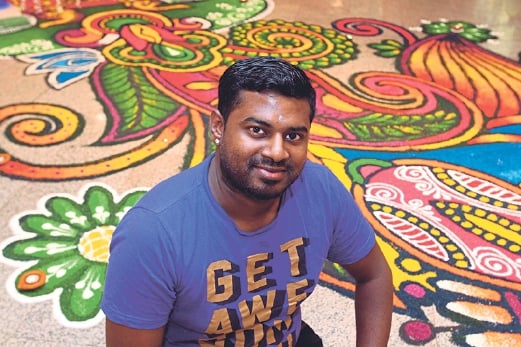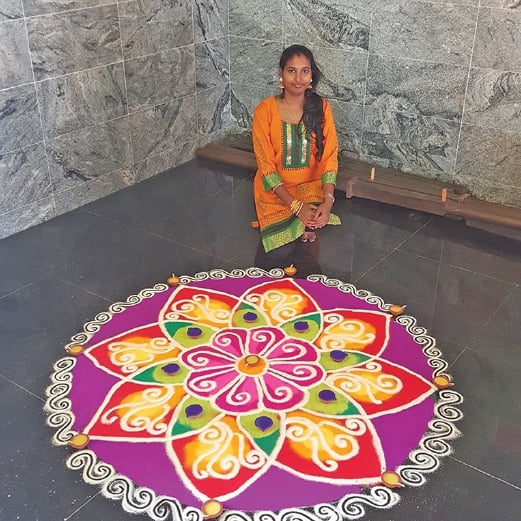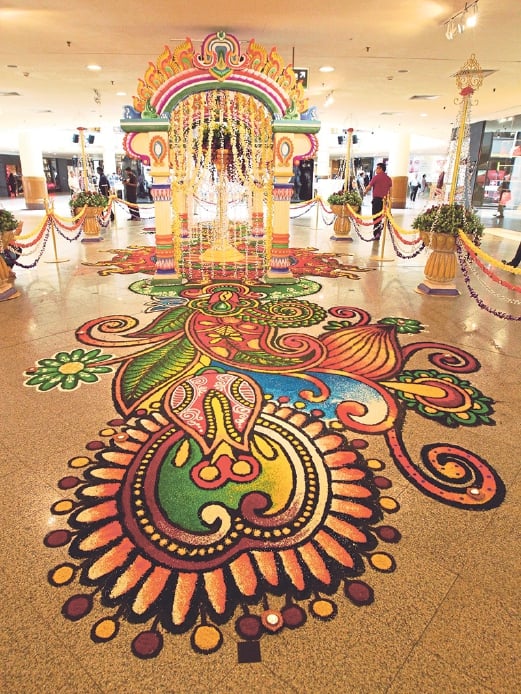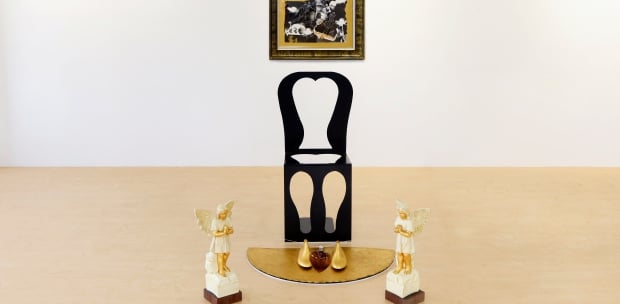ON a weekday, the buzz of shoppers roaming the courts of Midvalley Megamall in Kuala Lumpur usually mellow down into an eerie stillness by 10.30pm. The only audible thing at this hour is the cackling of service staff exiting the mall together after a long day and managers pulling down the shutters of their shops.
Lights go out one by one, leaving the space to only security guards on night shift who walk around, sometimes whistling a tune or two to break that deafening silence.
The week before Deepavali however, things are a little different. After most young people had left the building, a group of 10 students, led by an equally young artist, Rueben Prakash, walked in with whiteboard marker pens, sketches and buckets of coloured rice.
When the mall re-opened its doors to shoppers in the morning, Rueben and his team had completed a mammoth size kolam, by far one of the most recognisable artforms associated with the festival of lights.
The kolam in any setting, is like a light in the darkness; its vibrant hues pull people together. For shoppers and tenants alike, it is impossible to not stop, stare and whip out their smartphones for a selfie with this intricate, colourful artwork.
But for artists like Rueben and his team, kolams are more than merely decorative; they are heavy in cultural and spiritual significance.
ART OF DOTS AND CURVES
Kolam, meaning beauty, in Tamil is an ancient folk artform with a history spanning thousands of years. In South India, kolams are identified by their geometrical patterns, dots, curves and lines often marked by the use of white flour. In the north, where artists like Rueben take their inspirations from, the kolams are known as rangoli styles, with bright, vibrant colours.
The motifs and designs of rangoli vary, ranging from floral patterns to light lamps as well as animals which are considered auspicious to Hindus like elephants and peacocks.
“Even though the rangoli kolam is North Indian in origin, many families of Tamil origin here now like to use rangoli designs for their kolam because it is so beautiful to look at,” confides Rueben who has been crafting kolam since age 17.
Traditionally, the women in each family are tasked with crafting kolams for special occasions. “Prof Nyanasaundari Andavar, head of the Department of Physics at the S.F.R. College For Women in Sivakasi, India, and who has researched kolam, says in the book, The Art Of Dots And Curves, that the floor drawings also fulfill physical, philosophical and spiritual aims,” explains Devika Bai in an article written in New Straits Times in 1991. The physical aspect, she writes, involves the stretching of arms, waist and legs across while drawing the kolam. Philosophically, the act of bending one’s body and head is a sign of humility. Spiritually, the concentration and calmness when crafting a kolam is related to meditation (dhyana).
“You have to be so patient to draw a kolam,” Rueben says. “It takes days to work on the design and colours, then another three days to dye the broken rice. Depending on the size, it takes hours of sitting down or kneeling and filling the design with the coloured rice, layer by layer.”
He notes that the main kolam in Midvalley Megamall took his team 11 hours to complete.
LIGHT OF LIFE
“This is by far the biggest kolam we have done,” Rueben says, looking longingly at the finished kolam, stretched across 18m at the main entrance of Midvalley Megamall.
“We’ve been doing this for years, and every day for two weeks right till Deepavali, we are crafting kolams at the entrances and grounds of different malls and hotels,” he says with a contented smile.
The kolam, Rueben says, is an important part of welcoming people to homes during Deepavali.
“Before people step into your house, you want to be able to greet them with something beautiful. So usually a kolam is always at the front of the house,” he shares, adding that the colours and designs usually evoke a smile on the faces of those who look at it. “When people are happy, you welcome joy, good luck and happiness into your home,” he adds.
As Dokka Srinivasu, a Indian heritage enthusiast from Andhra Pradesh in India explains, kolams also bear religious significance, making it a must-have during traditional Indian festivals such as Ponggal, Onam and Deepavali.
He says: “Kolams are meant to be sacred welcoming areas for the Hindu deities. The ancient symbols have been passed down through the ages, from each generation to the next, keeping both the artform and the tradition alive.”
GIVING BACK TO NATURE
“In most rangoli kolams around the world, people use broken rice,” says Nethya Kalyani Sinnapayan, a local kolam artist who spearheads Neetha Art Academy. “I have opted to use Indian flour, the kind we use in the making of the Indian dessert, kesari, because it is a little sweeter.”
Whether flour or broken rice, the significance as Nethya points out, is the same. “Kolam is not just about decorating. Many use broken rice and Indian flour because it is also a way of inviting insects and ants to share in the blessing. Insects and bugs can eat both,” she explains.
Nethya chooses to use Indian flour out of respect for the staple food. “Personally, I feel using rice is disrespectful as rice is a staple, something that many people around the world rely on for sustenance. Unfortunately, there are people who throw away the broken rice instead of giving it to the birds,” says Nethya.
She adds that there are people who do not know the significance of kolam or dye their rice or flour with artificial colouring, making the kolam inedible for insects.
Rueben concurs: “It is an important aspect of the kolam, to give back to nature. After Deepavali, we will collect the broken rice and feed it to the birds.”
INTRICATE ART
The art of kolam is something that is perfected over years of training. For Rueben, trial and error have been his greatest teachers. “I have always liked colours so this seemed like the most natural thing.”
The toughest part is mixing the colours. “It takes years to know how to colour the rice. Too much or too little can change the consistency of the colour,” he shares.
Like Nethya, Rueben also teaches classes on kolam art. “I was brought up in The Pure Life Society under the guidance of Mother Mangalam. Now I teach kolam art to the children in the ashram. I know how it helped me as a child from a broken home and how it can help them too.”
For Nethya, kolam has an equally deep, personal meaning. “It’s good that people of all races and religions can appreciate the beauty of kolam. But I want to bring awareness about the spiritual and cultural significance of kolam to Malaysians,” she says of her decision to start the art academy.
“It is more difficult to craft a kolam with flour, but this was how I was taught, so this is the way I create my kolams,” says Nethya who received her training in kolam art in Tiruchirappalli, in the Indian state of Tamil Nadu.
The kolam, she emphasises, is the blessing of God. “A kolam is like a colourful heart. It is full of joy, blessings and light.”
No matter how dark it is when the mall shuts down at 10.30pm, there will be one, big, bright light at the entrance of Midvalley Megamall till the end of Deepavali.








